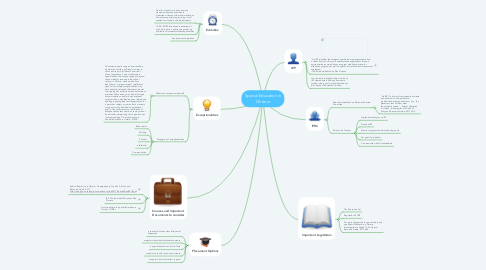
1. Evolution
1.1. Goal for schools is to have as many students with exceptionalities in mainstream classes with accommodations. Sometimes special programming is still needed for students with higher needs.
1.2. 1980 - Bill 82 Introduced mandating all schools to have a special programming available for students with exceptionalities
1.3. See Important legislation
2. Exceptionalities
2.1. What is an exceptional student?
2.1.1. All students require support from teachers, classmates, family, and friends in order to thrive and to gain full benefit from their school experience. Some students have special needs that require supports beyond those ordinarily received in the school setting. In Ontario, students who have behavioural, communicational, intellectual, physical or multiple exceptionalities, may have educational needs that cannot be met through regular instructional and assessment practices. These needs may be met through accommodations, and/or an educational program that is modified above or below the age-appropriate grade level expectations for a particular subject or course. Such students may be formally identified as exceptional pupils. The ministry sets out definitions of exceptionalities that must be used by school boards after determining that a student is an “exceptional pupil”.An Introduction to Special Education in Ontario. (OME)
2.2. Categories of exceptioanalities
2.2.1. Behavioural
2.2.2. Multiple
2.2.3. Physical
2.2.4. Intellectual
2.2.5. Communication
3. Sources and Important Documents to consider
3.1. Special Education in Ontario, Kindergarten to Grade 12, Policy and Resource Guide, 2017 http://edu.gov.on.ca/eng/document/policy/os/2017/SpecEdFinal2018.pdf
3.2. IEP: The Individual Education Plan Process
3.3. An Introduction to Special Education in Ontario. (OME)
4. Placement Options
4.1. a special education class with partial integration
4.2. a regular class with withdrawal assistance
4.3. a special education class full time
4.4. a regular class with resource assistance
4.5. a regular class with indirect support
5. IEP
5.1. "An IEP identifies the student's specific learning expectations and outlines how the school will address these expectations through appropriate accommodations, program modifications and/or alternative programs as well as specific instructional and assessment strategies." -The Individual Education Plan Process
5.2. If a student is identified there must be an IEP created within 30 days, however a student who is not formally identified can also have an IEP created for them.
6. IPRC
6.1. Stands for Identification Placement Review Committee
6.1.1. "An IPRC is a formal committee that meets and decides if a student should be identified as exceptional and, if so, the placement that will best meet the student’s needs." - Special Education in Ontario, Kindergarten to Grade 12, Policy and Resource Guide, 2017 pD2
6.2. Roles of the Teacher
6.2.1. Implement strategies on IEP
6.2.2. Develop IEP
6.2.3. Monitor progress towards acheiving goals
6.2.4. Set goals for students
6.2.5. Communicate with all stakeholders
